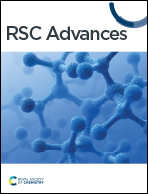Efficient Buchwald–Hartwig and nitrene-mediated five-membered ring closure approaches to the total synthesis of quindoline. Unexpected direct conversion of a nitro group into a phosphazene†
Abstract
Two total syntheses of quindoline, which take place through the intermediacy of 3-nitroquinoline derivatives, are reported. The general synthetic sequence involves construction of the latter by mechanochemical condensation of benzaldehydes with 2-amino-nitrostyrene, followed either by reduction of the nitro group of the heterocycle and Buchwald–Hartwig cyclization or by a nitrene-mediated cyclization under solventless conditions. Use of PPh3 to generate the nitrene resulted in the unprecedented formation of a phosphazene in place of quindoline. This unexpected transformation was explained by means of DFT computations.



 Please wait while we load your content...
Please wait while we load your content...